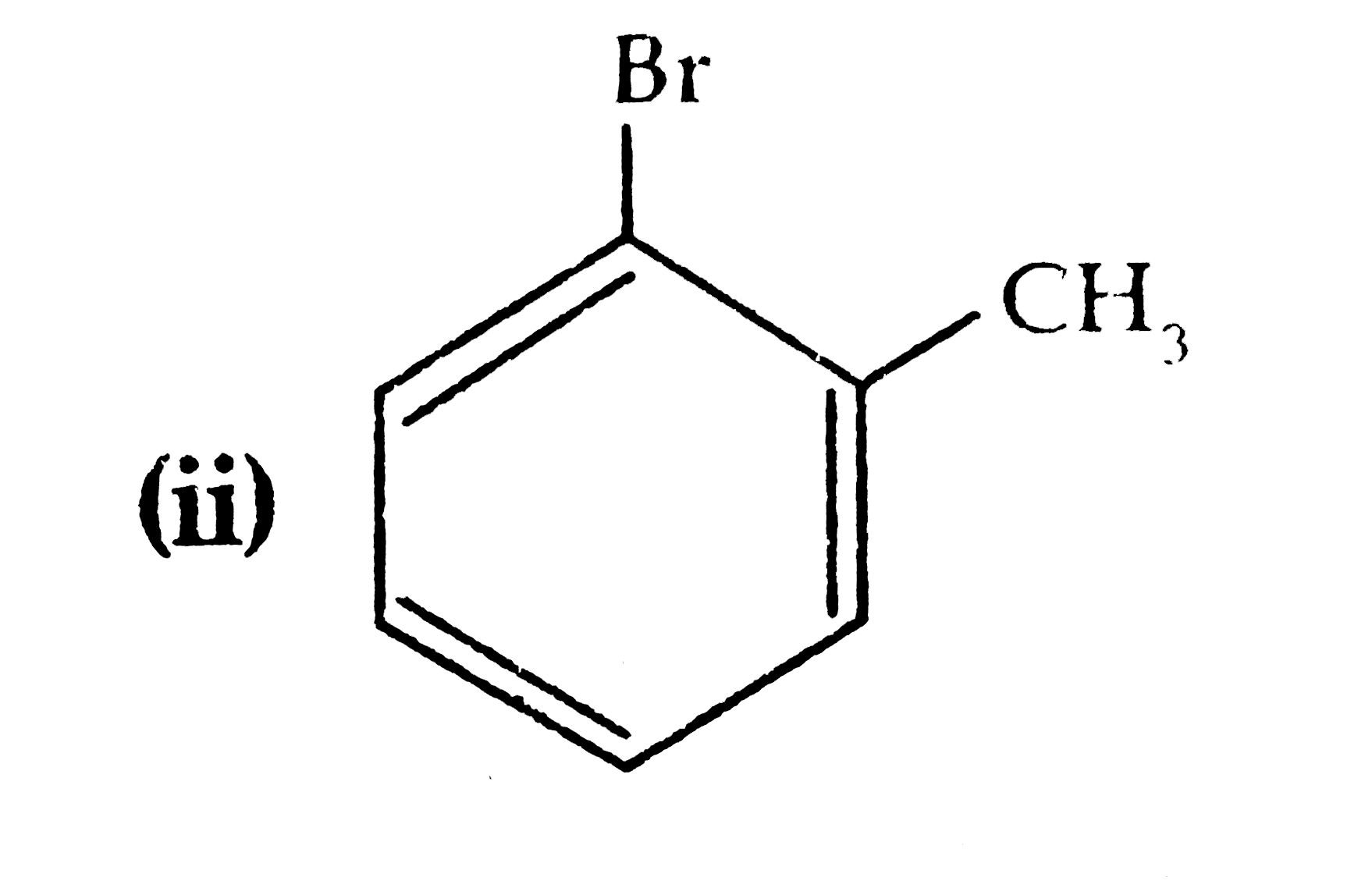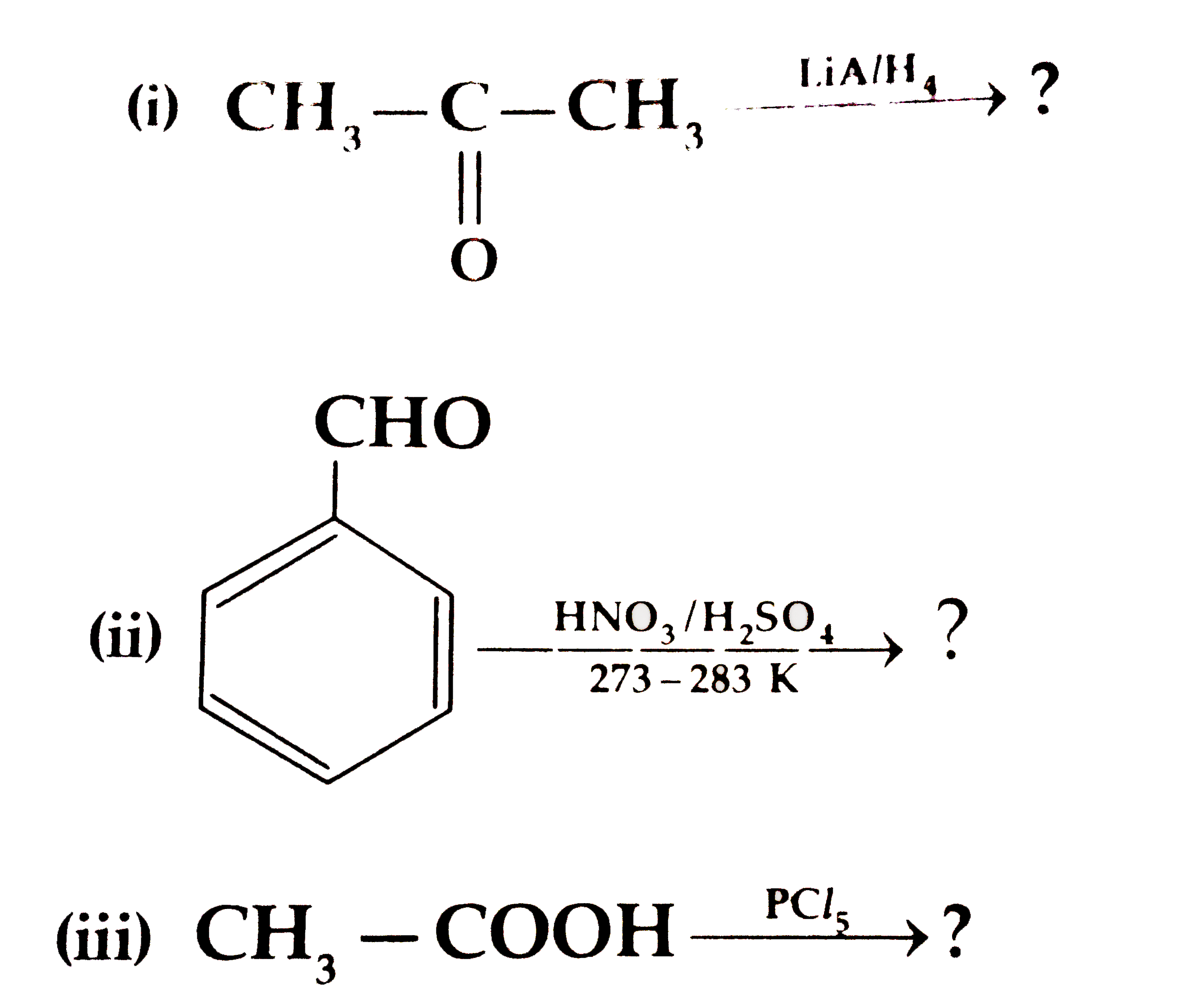Complete Solutions to Set - 1 Comptt. of chapter XII BOARDS of Class 12 book with complete answers and questions
| Class 12 | CHEMISTRY |
| Chapter | XII BOARDS |
| XII BOARDS PREVIOUS YEAR | Set - 1 Comptt. |
| Number Of Questions | 30 |
| Academic Year | 2023-24 |
What is the no. of atoms per unit cell (z) in a body -centred cubic strcuture ?
View SolutionIn reference to surface chemistry, define dialysis.
View SolutionWhat is the IUPAC name of complex `[Ni(NH_3)_6]Cl_2`?
View SolutionDraw the structure of 3-methyl-pentanal.
View SolutionComplete the following reaction equation :
`C_6H_5N_2Cl+H_3PO_2+H_2Oto.....`
View SolutionDefine osmotic pressure of a solution. How is the osmotic pressure orelated to the concentration of a solute in a solution ?
View SolutionDefine the following terms :
(i) Half- life of a reaction `(t_(1//2))`
(ii) Rate constant `(k)`.
View SolutionDraw the structure of the following :
(i) `H_2SO_4`
(ii) `XeF_2`
View SolutionWhat is meant by 'disproportionation'? Give an example of disproportionation reaction in aqueous solution.
OR
Suggest reasons for the following features of transition metal chemistry:
(i) The transition metals and their compounds are usually paragmagnetic.
(ii) The transition metals exhibit variable oxidation states.
View SolutionExplain the mechinism of dehydration steps of ethanol:
`CH_3CH_2OHoverset(H+)underset (443K) to CH_2=CH_2+H_20O`
View SolutionExplain the following terms with suitable example:
a. Schottky defect b. Frenkel defect
c. Interstitials d. F-centres
View Solution`45 g` of ethylene glycol `C_(2)H_(6)O_(2)` is mixed with `600 g` of water. Calculate (a) the freezing point depression and (b) the freezing point of solution.
Given`K_(f)=1.86 K kg mol^(-1)`.
View SolutionThe rate constant of a reaction at `500 K` and `700 K` are `0.02s^(-1)`, respectively. Calculate the values of `E_(a)` and `A` at `500 K`.
View SolutionDefine the following terms :
(i) Electrophoresis
(ii) Adsorption
(iii) Shape selective catalysis
View SolutionOutline the principels of refining of metals by the following methods :
(i) Distillation
(ii) Zone refining
(iii) Electrolysis.
View SolutionWrite down the reactions taking place in different zones in the blast furnace during the extraction of iron.
View SolutionWhat is lanthanoid contraction? What are the consequences of lanthanold contraction?
View SolutionIndicate the types of isomerism exhibited by the following complexes :
(i) `[Co(NH_3)_5(NO_2)]^(2+)`
(ii) `[Co(en)_3]Cl_3` (en= ethylene diamine)
(iii) `[Pt(NH_3)_2Cl_2]`
View SolutionName the following according to IUPAC systems :
(i) `CH_3-underset(OH)underset(|)CH-CH_2-CH_3`
(ii)
(iii) `CH_3-overset(CH_3)overset(|)underset(CH_3)underset(|)C-CH_2-Cl`
View SolutionHow are the following conversions carried out ?
(i) Propene to propan-2-ol
(ii) Benzyl chloride to Benzyl alcohol
(iii) Anisole to p-Bromoanisole
View SolutionAn aromatic compound (A) on treatment with aqueous ammonia and heating forms compound (B) which on heating with ` Br_2` and ` KOH` forms a compound (C) of the molecular formula ` C_6 H_7 N`. Write the structures and `IUPAC` names of compounds (A), (B) and (C).
View SolutionHow are vitamins classified? Name the vitamin responsible for the coagulation of blood.
View SolutionWrite the names and structures of the monomers of the following polyers :
(i) Buna -S
(ii) Neoprene
(iii) Teflon
View SolutionRamesh went to a department store to purchase groceties. On one of shelves he notcied. Sugar-free tablets. He decided to buy them for his grandfather who was a diabetic. There were three types of sugar-free tablets. Ramesh decided to buy sucrolose which was good for his grandfather's health.
(i) Name another sugar-free tablet which Ramesh did not buy.
(ii) Was it right to purchase such medicines without dcotor's prescription ?
(iii) What quality of Ramesh is reflected above ?
View SolutionDefine the following terms :
(i) Molar conductivity `(wedge_(m))`
(ii) Secondary batteries
(iii) Fuel cell
(b) State the following laws :
(i) Faraday first law of electrolysis
(ii) Kohlrausch's law of independent migration of ions.
View SolutionDefine the term degree of dissociation. Write an expression that relates the molar conductivity of a weak electrolyte to its degree of dissociation.
(b) For the cell reaction
`Ni(s)|Ni^(2+)(aq)"||"Ag^(+)(aq)|Ag(s)`
Calculate the equilibrium constant at `25^@C`. How maximum work would be obtained by operation of this cell ?
`E_((Ni^(2+)//Ni))^(@)=-0.25V and E_((Ag^(+)//Ag))^(@)=0.80V`
View Solution(a) Complete the followingh chemical reaction equations :
(i) `Cu+HNO_(3 (dilute))to`
(ii) `P_4+NaOH+H_2Oto`
(b) (i) why does `R_3P=O` exist but `R_3N=O` does not ? (R=alkyl group)
(ii) why is dioxygen a gas but sulphur a solid ?
(iii) why are halogens coloured ?
View Solution(a) Write balanced equations for the following reactions :
(i) Chlorine reacts with dry slacked lime.
(ii) Carbon reacts with concentrated `H_2SO_4`.
(b) Describe the contact process for the manufacture of sulphuric acid with special referecen to the reaction conditions, catalysts used and the yields in the process.
View SolutionDescribe the following giving chemical equations :
(i) De-carboxylation reaction.
(ii) Friedel-Crafts reaction
(b) How will you bring about the following conversions ?
(i) Benzoic acid to Benzaldehyde
(ii) Benzene to m-Nitroacetophenone
(iii) Ethanol to 3-Hydroxybutanal.
View Solution(a) Describe the following actions :
(i) Acetylation
(ii) Aldol condensation
(b) Write the main proudction in the following equations : (i) `CH_3-underset(O)underset(||)C-CH_3overset(LiA//H_4)to`?
(ii)
(iii) `CH_3-COOHoverset (PCl_5)to` ?
View Solution
Set - 1 Comptt. questions and complete solutions for chapter XII BOARDS of XII BOARDS PREVIOUS YEAR of Class 12
All Exercises from XII BOARDS PREVIOUS YEAR Class 12 CHEMISTRY XII BOARDS
- C.B.S.E CLASS XII
- C.B.S.E CLASS XII
- C.B.S.E. CLASS - XII
- C.B.S.E. CLASS - XII
- C.B.S.E. CLASS-XII
- C.B.S.E. CLASS-XII
- CHEMISTRY (THEORY)
- CHEMISTRY (THEORY)
- CHEMISTRY (Theory) [SET - I]
- CHEMISTRY (Theory) [SET - I]
- Delhi Board : Set - II
- Delhi Board : Set - II
- Delhi Board : Set - III
- Delhi Board : Set - III
- DELHI BOARD SET II
- DELHI BOARD SET II
- General Instrucations
- General Instrucations
- IMPORTANT QUESTIONS FOR PRACTICE CHEMISTRY (THEORY-XII) UNSOLVED)
- IMPORTANT QUESTIONS FOR PRACTICE CHEMISTRY (THEORY-XII) UNSOLVED)
- OUTSIDE DELHI (SET-I)
- OUTSIDE DELHI (SET-I)
- Outside Delhi : SET-I
- Outside Delhi : SET-I
- Outside Delhi : SET-II
- Outside Delhi : SET-II
- Outside Delhi : SET-III
- Outside Delhi : SET-III
- Outside Delhi : SET-II
- Outside Delhi : SET-II
- Outside Delhi : SET-III
- Outside Delhi : SET-III
- Outside Delhi Board: Set-III
- Outside Delhi Board: Set-III
- Outside Delhi: Set-II
- Outside Delhi: Set-II
- QUESTION PAPER (SECTION-A)
- QUESTION PAPER (SECTION-A)
- QUESTION PAPER (SECTION-B)
- QUESTION PAPER (SECTION-B)
- QUESTION PAPER (SECTION-C)
- QUESTION PAPER (SECTION-C)
- Questions
- Questions
- SECTION-A
- SECTION-A
- SECTION-B
- SECTION-B
- SECTION-C
- SECTION-C
- SECTION-D
- SECTION-D
- Set - 1 Comptt.
- Set - 1 Comptt.
- SET - II
- SET - II
- Set -I
- Set -I
- Set -II
- Set -II
- Set -III
- Set -III
- Set I
- Set I
- Set II
- Set II
- Set III
- Set III
- SET- I
- SET- I
- SET- II
- SET- II
- SET- III
- SET- III
- SET-1
- SET-1
- SET-I
- SET-I
- SET-II
- SET-II
- SET-III
- SET-III
- [OUTSIDE DELHI : SET - III]
- [OUTSIDE DELHI : SET - III]
- [OUTSIDE DELHI : SET - II]
- [OUTSIDE DELHI : SET - II]
- [OUTSIDE DELHI : SET -III]
- [OUTSIDE DELHI : SET -III]
- [OUTSIDE DELHI : SET -II]
- [OUTSIDE DELHI : SET -II]
- [SET-1]
- [SET-1]
- [SET-III]
- [SET-III]
- [SET-II]
- [SET-II]
- [SET-I]
- [SET-I]